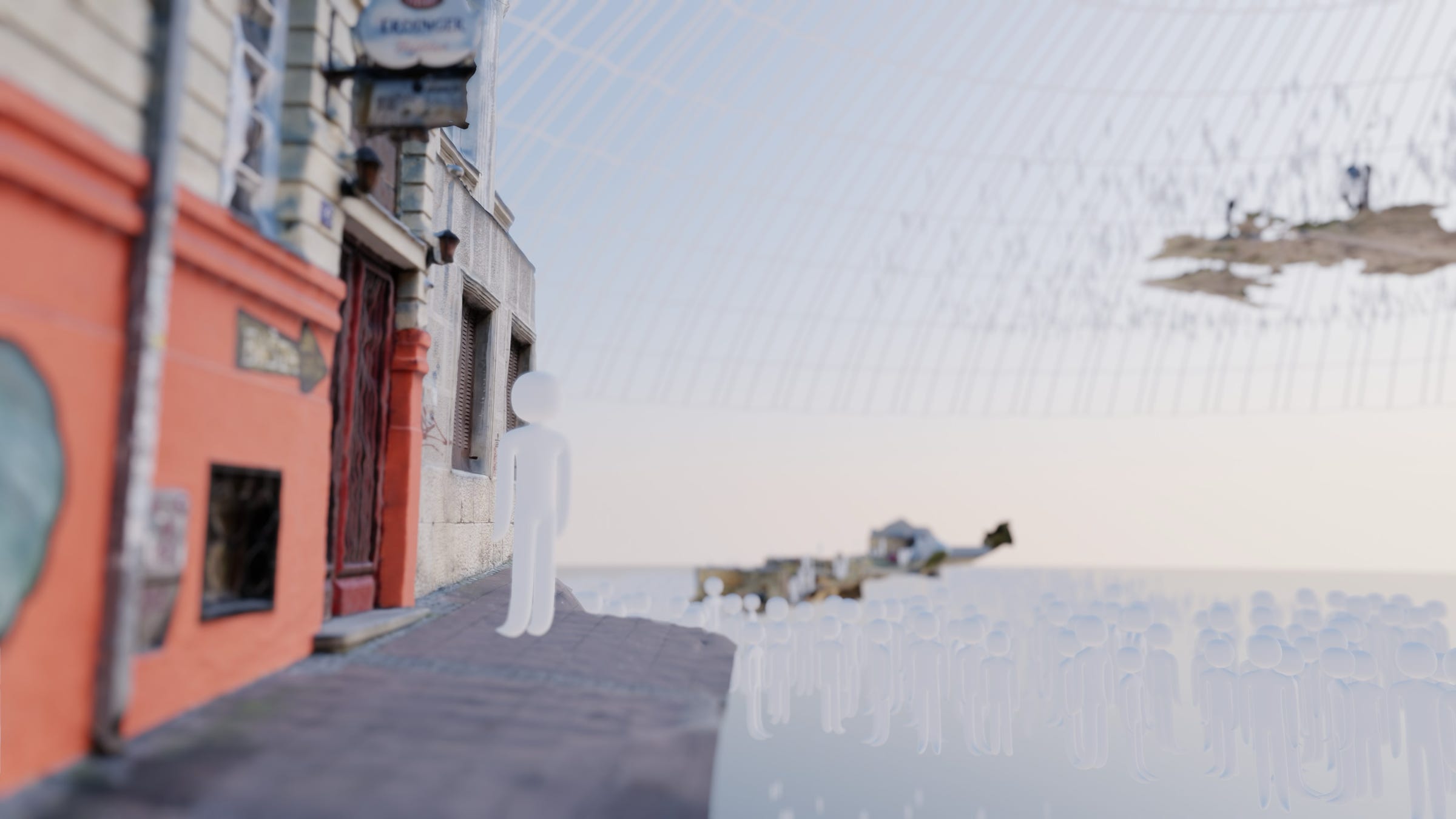One Shuts One Eye
by Nela Tonkovic
„The relationship of time and space as we experience it in travelling, has to this day something
illusionistic and illusory which is why we also, every time we come home from elsewhere,
never know with certainty whether we really went away.“
W. G. Sebald, Austerlitz
Nemanja Ladjic is an author who plays skillfully with categories of time and space. It seems that in his new video installations this „playing“ got more serious, that it can easily turn familiar places into unfamiliar ones and step through time, which is indeterminable. But is it „playing“ then, or a method that conceals a deeper intention? And what is the goal if that, almost alchemistic, decanting and overlapping of space and time? If „one shuts one eye“, maybe that will give a better view.
During last year we witnessed an obsession with virtual walks. Movement stopped completely, and during that „frozen“ moment people wanted to visit everything they hadn’t visited before, even if only vicariously. During the first few months of the lockdown museum virtual walks were among the most searched topics on search engines. But the interest soon faded – virtual walks were there just so that people could see something, but they couldn’t experience what they were seeing, and the loss in transfer of meaning was beyond apparent.
The author’s video installations, curious depictions of familiar surroundings consist of virtual „strolls“ by/above/under/over the objects that the author chose for making a whole. Those objects are recorded using photogrammetry, and that is why the described route can be followed in such a way and be visible from all sides – their presence is even more striking, because they don’t look like backdrop. The observer is not required to physically move in order to communicate with the work – although the observer himself is static, his state isn’t still – it’s motion, because the movement is „embedded“ in the work. If the observer accepts the route suggested by the work, he is in for a special kind of „tourism“ – a trip down memory lane. In that moment he will find himself in a seemingly paradoxical situation Sebald was describing at the beginning of this text – all journeys contain something unrealistic, something that turns them into dreams that are and aren’t our real life. When it comes to travelling through memories, the impression is even more deceiving, because memories used to be life itself, but in the moment of remembering them they exist only as records far from our immediate reality, therefore they seem unreal. Or maybe they are twice as real – because they used to be reality and they become reality once again when we remember them? Now Sebald’s phrase doesn’t seem so paradoxical anymore, and the author’s video installations don’t resemble everyday „strolls“.

While the familiar objects appear in front of him, many of which he may be passing by every day, the observer intuitively realizes that what’s in front of him are not just places – they are memories. The ease with which one flows from one object to the other surpassing distances, weightlessly passing through one space to another, the view that inquisitively surrounds them, as if to remember them as well as possible, the developing impression of closeness towards everything that is observed – all of that is a part of methods of memories. Only memories have that much freedom.
Works of Nemanja Ladjic persist on that very frequency of experiencing freedom. The author takes us through spaces he himself has built, connecting them led by his own choosing, selecting what he deems memorable. By walking – or maybe floating – which invites the observer to go through these spaces, he irreversibly determines the relation and the connection that is formed between the objects in his work, but also the one between the observer and the work itself. By focusing the observer’s gaze in front of a certain point, Ladjic gives him the opportunity to enter the work more fully and start revealing the layers of its meaning.
By shutting one eye, maybe the observer will see himself in a similar situation, maybe he will wonder why he is taking that particular road, why that snippet of life he passes by seems so intimately familiar. He will want to discover how he got to where he was, how he entered another reality without ever leaving the gallery. He will feel the need to take „a stroll“ down his own ruins. He will probably understand that memories are, sometimes, more real than any seemingly visible reality.
The works of Nemanja Ladjic encourage a different view and a new evaluation of our surroundings, giving them a dimension that everyday life takes away from them. Our immediate surroundings shaped in a form of a „virtual stroll“ inevitably turn into a „memory lane“, whose meanings and importance are embedded deep within us. We return from our journey down that lane believing we have only slightly derailed from our usual stream of life, we barely needed to move. But that’s where the strength lies: almost unnoticeably, everything within us has changed, although we stayed in the same spot. The geography didn’t change – we did.
Translated by Ana Acović